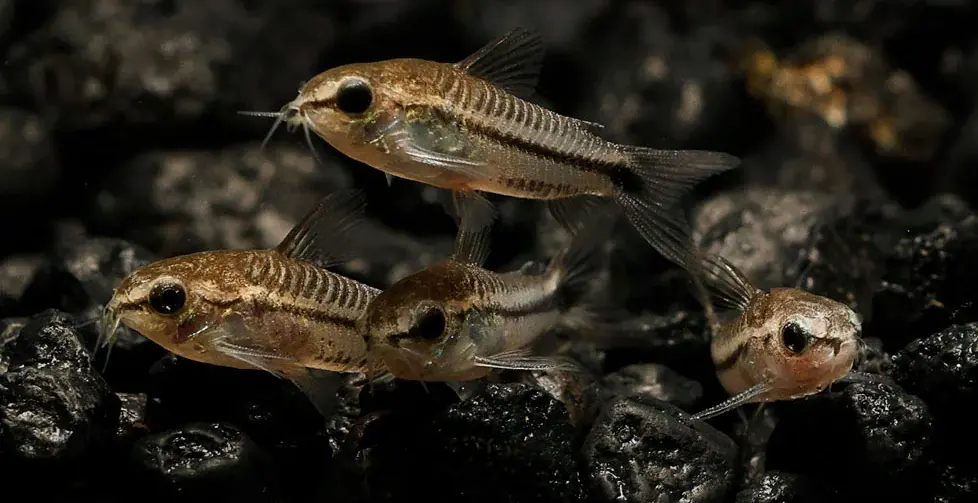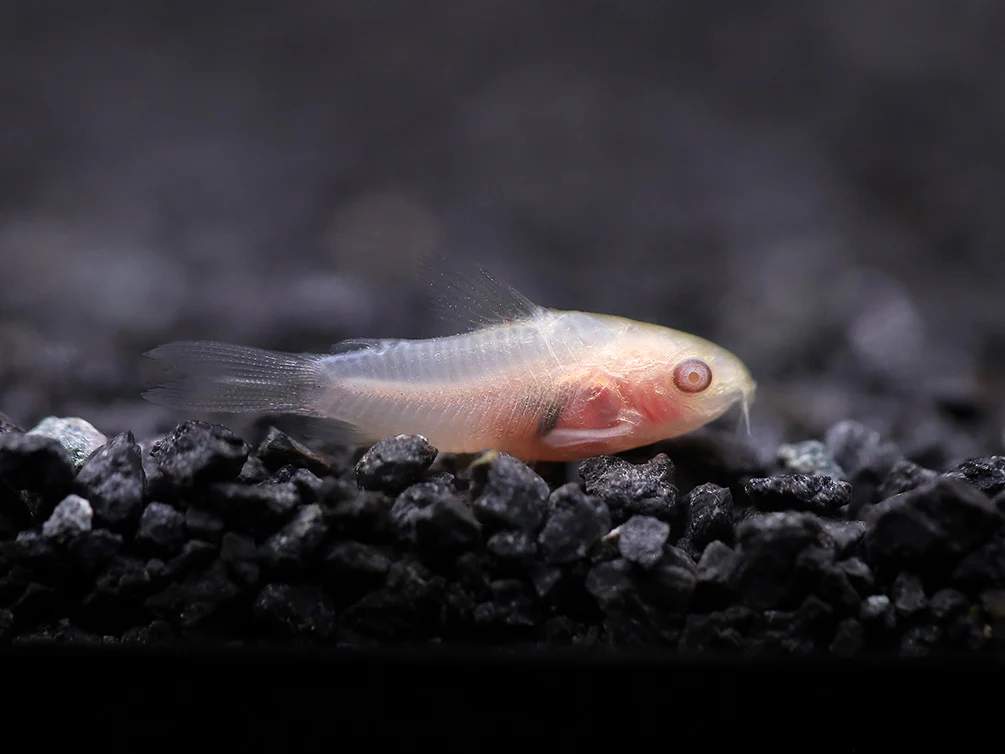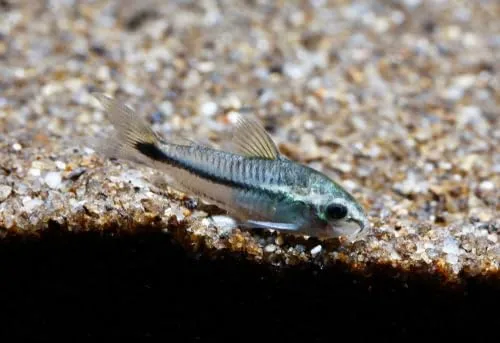Pygmy Corydoras (Corydoras pygmaeus)
Pygmy corydoras (Corydoras pygmaeus) are tiny, peaceful freshwater catfish that make fantastic additions to community aquariums. Unlike many other corydoras species that stay near the bottom of the tank, pygmy corys are known for mid-water schooling, which adds lively activity and personality to an aquarium. They are suitable for beginners and experienced aquarists alike, as pygmy corydoras care is considered fairly easy when their basic needs are met.
As a dwarf species, pygmy corydoras are one of the smallest catfish commonly available in the aquarium trade, making them ideal for nano to mid-sized community tanks. They are social and thrive when kept in large groups of at least 6, but ideally 10 or more. You can find pygmy corydoras in many local fish stores across the United States, as well as from numerous online retailers such as Aquatic Arts.
Pygmy Corydoras Species Overview
Adult Size: ~1.2 inches (3 cm)
Lifespan: 3–4 years
Diet: Omnivore
Care Level: Easy–Moderate
Minimum Tank Size: 10 gallons
Temperature: 72–79°F (22–26°C)
pH: 6.0–7.5
Origin: South America (Brazil – Madeira River Basin)
Pygmy Corydoras Care
Pygmy cory care requirements are not demanding, but providing them with the right environment will help them thrive. Because they are social schooling fish, they do best in larger groups—the more you keep, the more natural and confident their behavior will be. In an aquarium, you will often find pygmy corys swimming in the middle levels of the tank, as well as darting to the substrate to forage.
A soft, sandy substrate is highly recommended to protect their delicate barbels. Dense planting and plenty of hiding areas will help pygmy corydoras feel secure. Driftwood, leaf litter, and fine-leaved plants like java moss also mimic their natural habitat well.

Feeding
Pygmy corydoras are omnivores, feeding on small insects, worms, crustaceans, and biofilm in the wild. In captivity, it’s important to provide a varied and nutritious diet to keep them healthy. High-quality micro sinking foods are ideal, as these fish feed primarily at the bottom of the tank.
Suitable foods include:
- Sinking micro pellets or wafers
- Crushed high-quality flakes
- Frozen or live foods such as baby brine shrimp, daphnia, or microworms
Their small mouths make it important to choose fine-sized foods. Avoid overfeeding, and ensure food reaches the bottom where they can access it.
Water Conditions
Pygmy corydoras do well in freshwater aquariums that meet stable water parameters. Like other corydoras species, they prefer clean, well-oxygenated water with minimal fluctuation in pH or temperature.
A gentle current and good filtration are recommended, as they originate from slow-moving streams and tributaries in the Amazon basin. Keep ammonia and nitrite at 0 ppm, and nitrates below 20 ppm for best health.
Pygmy corydoras prefer slightly acidic to neutral water (pH 6.0–7.5) and soft to moderately hard water, although they are quite adaptable. As with all corys, avoid sharp gravel substrates, as they can damage their barbels and increase susceptibility to infection.
Pygmy Corydoras Breeding
Breeding pygmy corydoras in captivity is possible and often easier than many other dwarf fish. Sexing them can be done visually, females are generally larger and rounder, especially when viewed from above.
To encourage spawning, maintain excellent water quality and provide plenty of fine-leaved plants or moss. A slight drop in temperature during water changes can simulate the rainy season, which often triggers breeding behavior. Males will chase females, and after a courtship “T-position,” the female will deposit adhesive eggs on surfaces such as plant leaves, glass, or décor.
Hatching and Fry Care
After eggs are laid, it’s best to separate them into a rearing tank to avoid predation. Use gentle filtration and keep lighting dim. Eggs typically hatch in 3–5 days.
Once fry are free-swimming, feed them with infusoria or commercially prepared fry food until they are large enough to accept baby brine shrimp or microworms. Fry are very sensitive to water quality, so small and frequent water changes are essential.

Common Pygmy Corydoras Diseases and Health Issues
Pygmy corys are generally hardy, but like all small fish, they are susceptible to stress-related issues. Common problems include barbelle erosion (often caused by sharp substrate or poor water quality), bacterial infections, and parasites.
Stress can weaken their immune system, so it’s essential to provide proper water quality, tank size, and group size. Quarantining new fish before adding them to a community tank will help prevent parasite or disease introduction. Avoid medications containing copper, as corydoras can be sensitive to them.
Pygmy Corydoras Tank Setup
The ideal pygmy cory tank setup includes a soft sand substrate, live plants, and plenty of hiding spaces. They feel most secure in a natural aquascape with driftwood, leaf litter, and low-to-moderate lighting. A group of at least 10–12 will help them school naturally and reduce stress.
A 10-gallon aquarium is suitable for a small group, but larger is always better, especially if housing with other fish. Stable, established aquariums with mature biofilm benefitting the fish are ideal.
Tankmates
Pygmy corydoras are peaceful and pair well with other small, non-aggressive community fish that enjoy similar water parameters. Some compatible tankmates include:
- Small rasboras (harlequin, chili, lambchop)
- Small tetras (ember, neon, green neon)
- Other dwarf corydoras species
- Otocinclus catfish
- Peaceful shrimp and snails
Avoid keeping pygmy corys with large or aggressive fish that may outcompete, harass, or eat them. Monitor tank behavior to ensure compatibility and a low-stress environment.
Pygmy Corydoras Care Summary
Pygmy corydoras make adorable and active additions to freshwater aquariums. Their peaceful nature, small size, and schooling behavior bring energy to a community tank. While pygmy corydoras care is not difficult, providing proper water conditions, soft substrate, and a sufficiently large group is key to their well-being. With the right environment and care, these charming nano catfish will thrive for years to come.

